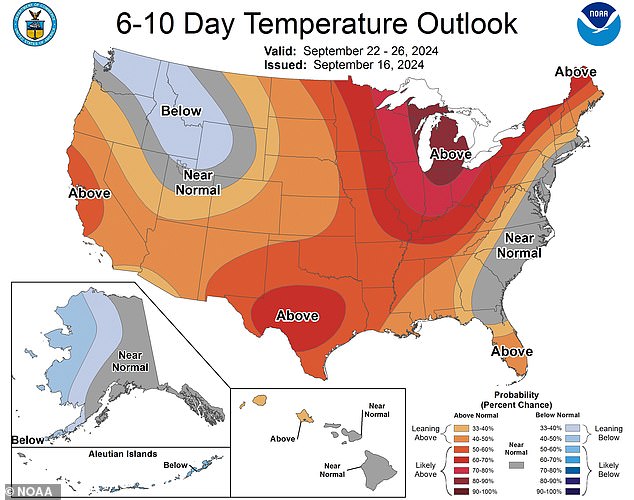Six states are set to see big temperature drops this week, according to a new forecast. Is YOUR hometown on the list?
Six states will see cooler temperatures this week as a “strong cold front” moves across the western United States.
In parts of Arizona, Nevada, Utah, Idaho, Wyoming and Montana, you can expect below-average temperatures over the next six to 10 days, with temperatures even exceeding 50 degrees in some areas.
The biggest change in temperature will be in Salt Lake City. Tuesday’s high was 19 degrees Celsius, which is 20 degrees cooler than Monday’s high.
And four other states — California, Oregon, Colorado and New Mexico — also have a smaller, but still significant chance of below-average temperatures.
The National Weather Service is predicting below-average temperatures, high winds and storms for six western states this week
“A change in the weather is coming,” the National Weather Service (NWS) office in Salt Lake City announced Saturday on X, formerly Twitter.
“Colder conditions will continue across Utah and southwestern Wyoming, beginning with a strong cold front on Tuesday. Temperatures are likely to remain below average for the next few days.”
The sudden drop in temperatures will come as a relief to people in the southwestern states, especially California, where temperatures recently soared above 65 degrees Fahrenheit (18 degrees Celsius) during a heat wave.
The cold front and associated winds originate from a low pressure area moving eastward through California.
This weather system will cool temperatures in California and likely bring the first significant snowfall to Yosemite National Park. Several inches of snow are expected to fall through Monday.
The cold front comes on the heels of a heat wave that has battered Southern California and neighboring parts of Nevada and Arizona since the first week of September, with temperatures soaring above 65 degrees Fahrenheit.
This week, temperatures in the Los Angeles area will drop to 77 to 80 degrees Fahrenheit, down from a normal high of around 80 degrees Fahrenheit.
In Nevada, cold, stormy weather has already reached the Las Vegas area since Monday.
In a proposition On X, the city’s local NWS office reported that a wind warning was in effect due to “gale force south-southwest winds 35 to 45 mph.”

If you live in Arizona, Nevada, Utah, Idaho, Wyoming and Montana, you can expect more fall-like temperatures this week
NWS Las Vegas also reported that temperatures dropped more than 10 degrees below average and will remain below average all week. Average September temperatures in this region typically range from 71 to 95 degrees Fahrenheit.
Highs this week will be in the upper 80s, rising into the 90s this weekend. But lows will drop into the mid 60s for the first half of the week before steadily rising into the low 70s.
The cold front also brought strong winds to the Salt Lake City area on Monday, with some spots recording wind speeds of up to 66 mph (106 km/h), according to NWS Salt Lake City.
“An approaching fall storm will bring some changes to the weather,” the office reported Monday on X. “In addition, Tuesday will be a maximum of 20 degrees Fahrenheit cooler than today.”
Tuesday is expected to be the coldest day of the week in Salt Lake City, with a high of 19 degrees. The average high temperature in September in this region is around 80 degrees Fahrenheit, Monica Traphagan, senior meteorologist with the NWS, told Newsweek.
In Arizona, wind and dust advisories are currently in effect for the western half of Imperial County. According to NWS Phoenix, wind gusts of 40 mph (64 kph) could create “areas of blowing dust,” reducing visibility to less than a mile in some areas.
The high in Phoenix on Monday was 102 degrees Fahrenheit, extending the streak of consecutive temperatures above 100 degrees Fahrenheit that the region has seen since May 27 by one day.
But the local NWS office predicts that trend could be broken on Tuesday, when temperatures drop into the mid-90s.

Next week, below-average temperatures will be less widespread, particularly in Idaho, Washington, Oregon, Montana, Utah and Wyoming.
Cooler temperatures and thunderstorms hit Boise on Monday. According to NWS Boise, daytime temperatures on Tuesday will be about 15 degrees cooler than normal for this time of year.
Thunderstorms moved through the Boise area around 8:45 p.m. Monday evening, bringing about 30 minutes of heavy rain, wind gusts up to 50 mph, and pea-sized hail.
Cheyanne is under a severe weather warning on Tuesday as this cold front increases the chance of a derecho, a widespread, long-lasting wind storm accompanied by a band of fast-moving showers or thunderstorms.
According to NWS Cheyanne, a derecho has not occurred in this region since June 2020.
“The greatest threat today is damaging wind gusts in excess of 70 mph,” the office said in a statement on X.
After this storm, temperatures will cool down, with afternoon temperatures dropping to 10 to 17 degrees Celsius. Strong winds are likely to continue blowing until Wednesday.
The average temperature in Cheyanne in September ranges from 9 to 25 degrees Celsius.
The Billings area is also under a severe thunderstorm warning Tuesday due to this cold front. Wind is the biggest risk, but there is a possibility the area could also see hail, according to NWS Billings.
In Billings, temperatures will drop to just over 5 degrees Celsius this week, slightly below the regional September average of 10 degrees Celsius.
Below-average temperatures will become less common in the western U.S. next week, affecting parts of Idaho, Washington, Oregon, Montana, Utah and Wyoming, according to the NWS’s latest six- to 10-day temperature forecast, which runs from Sept. 22 to 26.
In the rest of the U.S., most states can expect above-average temperatures next week, with the exception of the East Coast states from northern Florida to southern Massachusetts, where temperatures will be near normal.
